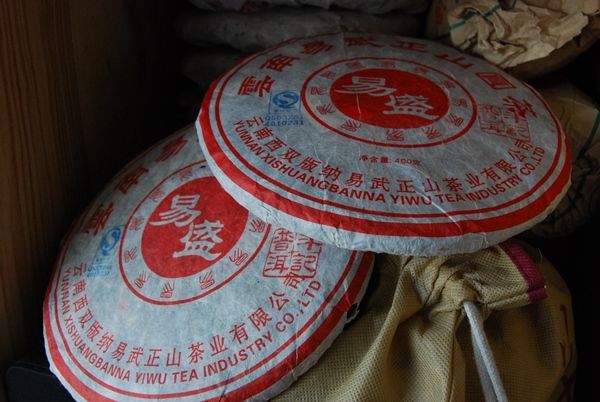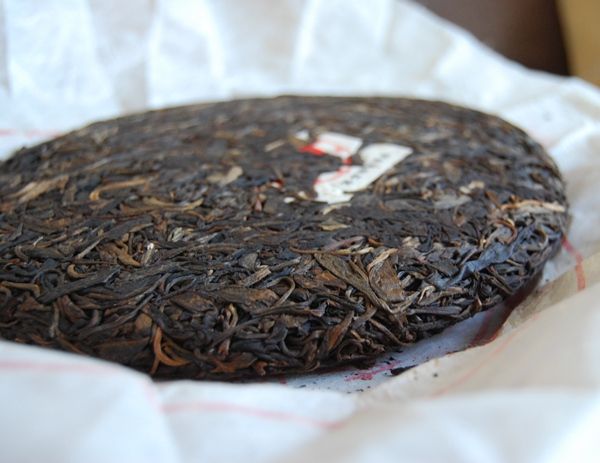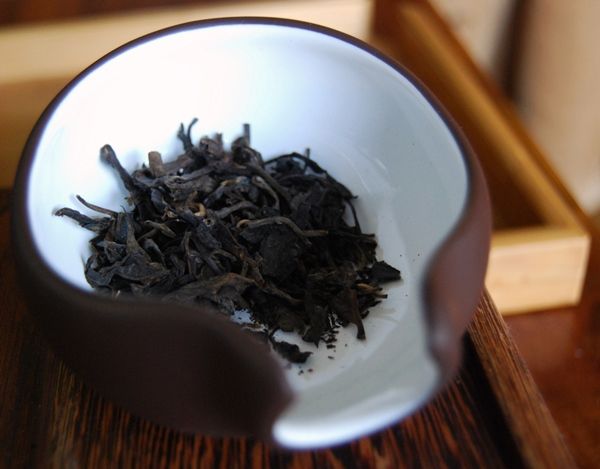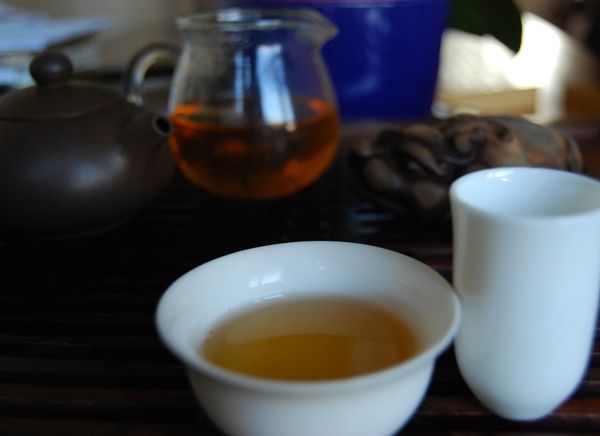Regular readers may remember the frantic Internetly amusement (and corresponding nuclear fall-out) caused by the 2005 Douji / Yisheng cakes, which come in red / purple colours and, seemingly, spring / autumn variants. I loved the 2005 Douji "Purple", and later compared the 2005 Douji "Red Autumn" with the 2005 Yisheng "Red", deciding that both were lovely, but that the latter was outstanding. My original thoughts on the Yisheng may be found here, which remain unchanged after much subsequent tasting.
Being a good sort, Scott of Yunnan Sourcing made some of the 2005 Douji "Red Spring" available, also known as the "Hongyisheng" (red "Yisheng", referring to the characters in the centre of the wrapper, and not to be confused with the 2005 Yisheng cake, which was mentioned above). These went for a relatively decent $62 - Scott's prices remain very fair.
The distinguishing factor here is that the cake is a 400g chubster, as marked on the wrapper, whereas the autumnal version is the usual 357g (and which is not marked on the wrapper). I have a cake of the autumnal version from Taobaowang, which was the source of the comparative article, and so look forward to comparing this spring version to it. We would assume, a priori, that this spring cake is probably more gutsy, which is A good Thing.
The good-sized leaves, pictured above, have a slight rustiness about their colour, which gives me hope for some decently-aged material. The proof of the pudding, they say, is in the tasting...
I like pudding, and I like this tea. The aroma is a punchy, heavy tobacco, which is just charming. Despite the heaviness, it remains bright and cheerful, with a good potency. It unfolds into a robust maltiness that is distinct from that sometimes associated with hongcha-style processing / accidents.
Bear in mind, gentle Reader, that Douji cakes usually adhere to a fairly consistent house style, and this cake is no exception. If you like that dark, dense character, then this cake will probably thrill you. If you are a drinker of tieguanyin, this may not be for you. Let the chips fall where they may.





4 comments:
Hi Hobbes,
I agree with your observations on this tea. I bought 2 cakes some time ago at YS and almost finished one of them already. The one downside I can mention is that the tea have some acidity which reminds me of menghai shu puerh somehow. I tend to wash this tea twice before brewing to mellow it slightly.
I want to ask you about QS stamp on the wrapper. I heard somwhere that QS stamp was introduced in 2006, but Red Yisheng is marked as 2005. What do you think? Is my information true at all?
Best,
Serg
Dear Serg,
I am impressed - you certainly know how to focus on a tea, given your rate of consumption! I seldom finish cakes, which is rather daft. There's simply too much variety. :)
As far as the blue "QS" stamp, I wouldn't like to make a guess without any information. It certainly seems as if this 2005 cake has the stamp, however!
Toodlepip,
Hobbes
This past month I also revisited the '05 Douji 'Red.' It did more for me than the Autumn Purple. The warm tobacco notes were pleasant and soothing. My only criticism would be a lack of progression in successive steeps. The flavor profile remained pretty even. Maybe for some this is a plus. Given a choice, I prefer pu's that unfold and develop a bit more. But then again I am probably splitting hairs.
Thanks for sharing your ongoing experience with these teas!
Dear Western Front,
Thanks for the comment - you raise a very interesting question: how does a tea develop over subsequent infusions?
Perhaps this is a heretical statement (he wrote, waggling his eyebrows provocatively), but I have come to conclude that there aren't many "young" cakes that have any recognisable progression. In older cakes, certainly: the "momentum" of the tea builds up over a number of infusions, revealing characteristics as the tea unfolds.
In younger teas, the twentieth infusions is either much like the first, or worse. If you're lucky, and have some real laoshu leaves in your younger cake, I find that it remains potent and pleasant. If less lucky, perhaps it cracks into something rough and nasty.
Maybe there is a slight progession in the first two or three infusions, as the floral notes of the dry leaves dissipate, but anything more? Any sign of a complex unfolding? A revealing of hidden charms? Not in many young cakes I've tried, at least. :)
Toodlepip,
Hobbes
Post a Comment